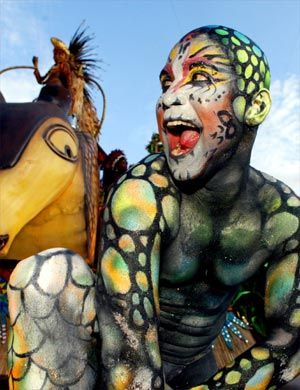After all, what is carnival?

The Brazilian Carnival (spelled Carnaval in Portuguese) is an annual celebration held forty days before Easter (marking the start of Lent), in Brazil. "Carnival" literally means "to put away the meat" it's root word being "carn" which means meat. It has some differences from its counterparts in Europe, as well there being variations across the large Brazilian territory. The Brazilian Carnival is known in Brazil simply as carnaval
Despite the Catholic inspiration, Brazilian Carnival is celebrated more as a profane feast than a religious event. Its origins are European, by a kind of carnival called Introito (Latin for entrance). The entrudo, as it was known in Brazil, could have been characterized mainly as a joke: to throw water (and later, other things) at other people, to "purify the body". The entrudo was prohibited, without success, in middle of the 19th Century, as it was considered violent by the upper classes (it is told that many people died from infections and other diseases, since even rotten fruits were sometimes thrown).
In the late 19th Century, the cordões (literally laces in Portuguese) were introduced in Rio de Janeiro, which consisted of groups of people who would walk on the streets playing music and dancing. The cordões were ancestors of the modern samba's school.
The blocos (blocks), another name for the cordões, are some of the current representations of the popular Brazilian Carnival. They are formed by people who dress in costumes according to certain themes, or to celebrate the carnival in specific ways. The schools of samba are truly organizations that work all year in order to prepare themselves for the samba schools parade.
The best-known Brazilian Carnival celebration takes place in Rio de Janeiro, with its samba schools, blocos and bandas occupying entire neighborhoods. In Salvador and other cities of the Northeastern Region, there is another form of the Brazilian Carnival: the Trio Elétrico. A trio elétrico is an adapted truck, with giant speakers and a platform where musicians play songs of local genres such as Axé music and Maracatu.
During the Carnival, a fat man is elected to represent the role of Rei Momo, the "king" of Carnival, whose rule is one of fun instead of that of everyday authorities.
extract from Wikipedia

0 Comments:
Post a Comment
<< Home